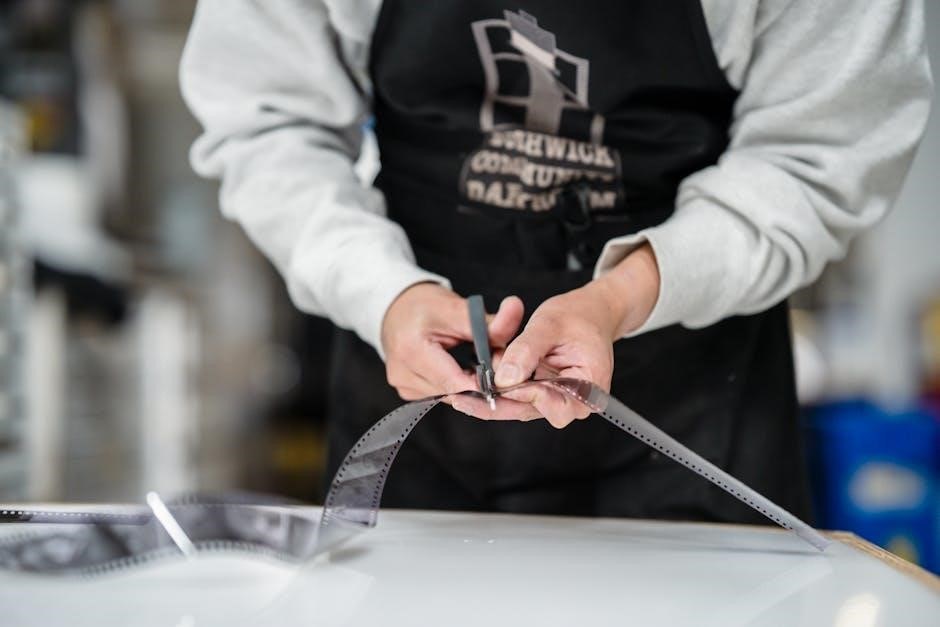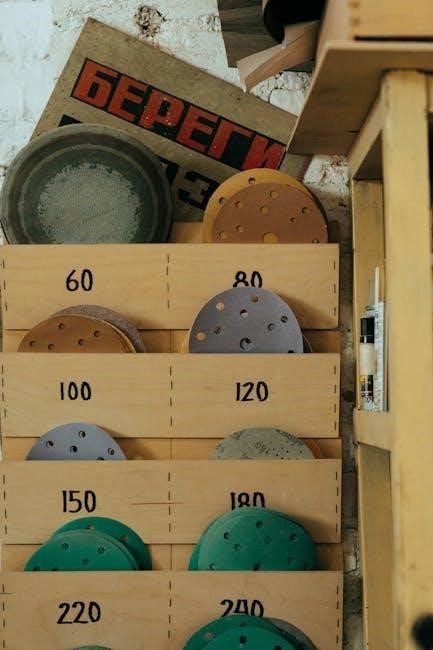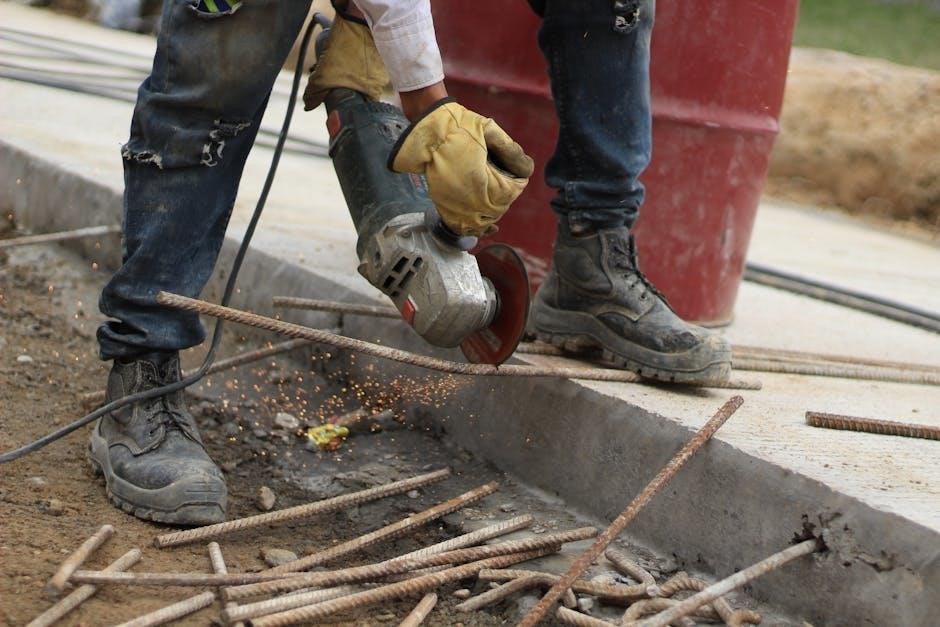Welcome to the comprehensive guide for your grain grinder. This manual covers everything from assembly to maintenance, helping you maximize efficiency and enjoy freshly ground grains effortlessly.
Overview of Grain Grinders
Grain grinders are essential tools for processing various grains, seeds, and legumes into flour, meal, or coarse textures. Designed for both manual and electric operation, they offer versatility and efficiency. Whether you’re grinding wheat, oats, or corn, these grinders ensure fresh, nutrient-rich ingredients. Made from durable materials like stainless steel or stone, they are built to last. Manual grinders provide a cost-effective, low-effort solution, while electric models deliver speed and convenience. Perfect for home bakers, health enthusiasts, or small-scale producers, grain grinders are a must-have for achieving high-quality results. Their compact designs and user-friendly interfaces make them accessible to everyone, ensuring consistent and reliable performance.
Importance of Using a Grain Grinder
Using a grain grinder is essential for retaining the nutritional value of grains, as it preserves vitamins and minerals often lost in commercial processing. Freshly ground ingredients ensure better flavor and texture in baked goods. Grinders also allow customization of grind size, catering to specific recipes. They are cost-effective, reducing reliance on store-bought flours. Additionally, grinding at home supports traditional cooking methods and provides healthier options by avoiding additives. Whether for bread, pastries, or specialty diets, a grain grinder enhances culinary versatility and promotes self-sufficiency. Its benefits extend to both health-conscious individuals and those exploring artisanal baking, making it a valuable addition to any kitchen.
Objective of the Manual
This manual aims to provide a detailed guide for optimal use of your grain grinder. It covers assembly, operation, maintenance, and troubleshooting, ensuring you get the most out of your appliance. The manual also offers tips for achieving the perfect grind and maximizing efficiency. By following the instructions, users can extend the grinder’s lifespan and enjoy consistent results. Whether you’re a novice or an experienced user, this guide helps you understand your grinder’s capabilities and use it effectively. The objective is to empower users with knowledge, ensuring safe and successful grinding experiences for years to come.

Types of Grain Grinders
Grain grinders are available in manual and electric models, catering to different needs. Manual grinders are ideal for home use, while electric ones handle heavy-duty tasks efficiently.
Manual Grain Grinders
Manual grain grinders are a cost-effective and eco-friendly option for grinding grains. They are ideal for small batches and offer precise control over the texture of the grind. These grinders are durable, easy to clean, and require no electricity, making them perfect for home use. Models like the Victoria Manual High Hopper Grain Grinder and the Country Living Grain Mill are popular choices, known for their sturdy construction and versatility. While manual grinding requires physical effort, it allows for a high level of customization and is a great way to ensure fresh, nutrient-rich flour. They are also a sustainable alternative to electric grinders, making them a favorite among health-conscious homeowners and baking enthusiasts.
Electric Grain Grinders
Electric grain grinders offer speed and convenience for grinding large quantities of grains. They are ideal for high-volume use, with milling rates typically measured in ounces per minute. These grinders are designed for efficiency, producing fine to coarse textures with minimal effort. Many models feature high-speed motors and durable stainless steel burrs, ensuring long-lasting performance. Electric grinders are perfect for bakers and households needing consistent results quickly. However, they may lack the portability and cost-effectiveness of manual grinders. Despite this, their ability to handle tough grains like wheat and corn makes them a practical choice for those prioritizing time and productivity in their grain grinding process.
Comparison of Manual and Electric Grinders
Manual and electric grain grinders each offer distinct advantages. Manual grinders are cost-effective, portable, and require no electricity, making them ideal for small batches or emergency use. They depend on user effort, with grinding times varying from 15 to 60 minutes for 6 cups of flour. Electric grinders, while more expensive, provide speed and efficiency, handling large quantities quickly. They are better suited for high-volume use but may lack portability and are noisier. Manual grinders are eco-friendly and low-maintenance, while electric grinders save time but require power. Choose based on your budget, space, and grinding frequency for the best fit.

Choosing the Right Grain Grinder
Selecting the ideal grain grinder involves considering budget, usage frequency, available space, and personal preferences for manual or electric operation to meet your grinding needs effectively.
Factors to Consider When Selecting a Grinder
When choosing a grain grinder, consider your budget, usage frequency, and available space. Manual grinders are cost-effective and ideal for occasional use, while electric grinders offer convenience and higher milling rates. Think about the types of grains you’ll grind most often and the desired texture. Durability and construction materials, such as stainless steel or stone, are crucial for long-term performance. Ease of use, noise level, and portability are also important factors. Additionally, check if the grinder can be motorized for future upgrades. Compare features like hopper size, milling speed, and warranty to ensure the grinder meets your needs and preferences effectively.
Top 10 Grain Grinder Models
Among the best grain grinders available, the Victoria Manual High Hopper Grain Grinder and Country Living Grain Mill stand out for their durability and performance. Electric models like the Grain Mill 150g High Speed Food Grinder offer quick results, while manual options such as the Family Grain Mill provide cost-effective solutions. Other notable models include the Salzburger Grain Mill Max and the Peugeot salt grinder, each catering to specific needs. When selecting, consider milling rates, ease of use, and construction quality. These top models balance efficiency, versatility, and value, ensuring you find the perfect fit for home or professional use. Explore these options to make an informed decision.
Victoria Manual High Hopper Grain Grinder
The Victoria Manual High Hopper Grain Grinder is a standout choice for home users seeking durability and efficiency. Built with a robust design, it excels at grinding various grains into fine flour. Its high hopper capacity allows for larger batches, making it ideal for families or small-scale production. The grinder is easy to operate and clean, ensuring a hassle-free experience. Known for its cost-effectiveness, it delivers quality results comparable to more expensive electric models. With its manual operation, it offers a sustainable and energy-saving solution for fresh grinding needs. Perfect for those prioritizing value and performance, the Victoria grinder is a reliable addition to any kitchen.
Country Living Grain Mill
The Country Living Grain Mill is a premium choice for grinding dry grains, renowned for its exceptional durability and performance. Weighing 20 pounds, it is built to last with a sturdy construction and a limited lifetime warranty. This mill stands out for its large capacity and ease of use, making it ideal for home bakers and enthusiasts. Its robust design ensures consistent grinding results, and the flywheel allows for easy manual operation. Additionally, it can be motorized for increased efficiency. Made in the U.S.A. for decades, the Country Living Grain Mill is a trusted option for those seeking high-quality, long-lasting grinding solutions for their culinary needs.

Safety Precautions and Maintenance
Always clean the grain grinder with a dry cloth before first use. Ensure the mill is securely fastened and remove handles before motorizing to ensure safe operation.
Safety Tips for Using a Grain Grinder
- Always secure the grinder on a stable surface before use to prevent accidents.
- Remove the handle when motorizing to avoid injury from moving parts.
- Only grind dry grains; moisture can damage the grinder or cause corrosion.
- Avoid overloading the grinder, as this can lead to malfunction or wear.
- Keep children and pets away while operating the grinder.
- Wear protective eyewear and ensure long hair is tied back during use.
- Regularly inspect and maintain the grinder to ensure optimal performance.
- Store the grinder in a dry place to prevent rust or damage.
Following these tips ensures safe and efficient grinding while extending the grinder’s lifespan.

Cleaning and Maintenance of the Grinder
Regular cleaning and maintenance are essential to ensure your grain grinder operates efficiently and lasts longer. Before first use, clean the grinder with a dry cloth to remove any dust or residue. After each use, brush out flour or grain particles from the grinding chamber and hopper. For tougher residue, gently scrub with a soft brush or cloth. Avoid using water, as it can cause rust or damage. Dry the grinder thoroughly if accidentally exposed to moisture. Regularly inspect and lubricate moving parts to prevent wear. Deep clean periodically by grinding rice or raw flour to absorb any residual oil or dust; Proper maintenance ensures optimal performance and extends the grinder’s lifespan.
Troubleshooting Common Issues
If your grain grinder experiences blockages, check for overloading or large grain pieces. Clean the auger and grinding chamber thoroughly. For uneven grind, adjust the grind setting or ensure grains are dry. If the grinder overheats, allow it to cool before resuming use. Lubricate moving parts if they feel stiff. For electric grinders, ensure proper power supply and check for jammed components. Manual grinders may require handle tightening or Burr realignment. Regularly inspect for wear and tear, replacing worn parts promptly. Addressing issues early prevents damage and ensures consistent performance. Always refer to the manual for specific troubleshooting steps tailored to your grinder model.

Assembly and Initial Setup
Begin by attaching the flywheel and hopper, ensuring all parts are securely fastened. For motorized use, install the V-belt and gear-reduced motor, removing the handle beforehand. Follow the manual for precise alignment and tightening to ensure smooth operation. Proper assembly ensures safety and efficiency, while incorrect setup may lead to poor performance or damage. Double-check all connections before first use to guarantee optimal grinding results and longevity of your grain grinder.
Step-by-Step Assembly Guide
Begin by cleaning the grain mill with a dry cloth before first use.
Attach the flywheel to the main axle, ensuring proper alignment.
Secure the hopper to the mill base using the provided screws.
Align the grinding stones or burrs and lock them in place with the axle pin.
Attach the handle firmly to the flywheel for manual operation.
If motorizing, install the V-belt and ensure the motor is securely fastened.
Double-check all connections and tighten any loose parts.
Perform a test run without grains to ensure smooth operation.
By following these steps, you’ll ensure a safe and efficient setup for your grain grinder.
First Time Usage Instructions
Welcome to your grain grinder! Before first use, ensure all parts are clean and dry. Familiarize yourself with the hopper, grinding stones or burrs, and adjustment knob. Add a small batch of grains to the hopper, turning the handle slowly for manual grinders. For motorized models, ensure the motor is securely attached and start at a low speed. Adjust the knob for your desired grind consistency. Monitor the output and stop if needed to clear blockages. Always keep loose clothing tied back and avoid overloading. After use, clean the grinder thoroughly. Experiment with different grains and settings to achieve your perfect grind. Happy grinding!

Grinding Techniques and Tips
For optimal results, use the right grind size for your recipe. Feed grains evenly and adjust settings as needed. Clean the grinder regularly for consistent performance.
How to Achieve the Perfect Grind
Achieving the perfect grind requires adjusting the grinder settings based on the type of grain and desired consistency. Start with coarse grinding for cereals and finer settings for flour. Use a consistent feeding rate to avoid clogging. For electric grinders, monitor the motor speed to prevent overheating. Manual grinders benefit from steady, rhythmic turning. Regularly clean the grinding surfaces to ensure optimal performance and flavor. Experiment with small batches to refine your technique, ensuring each grind meets your recipe’s needs. Proper adjustment and maintenance are key to consistent results.
Tips for Efficient Grinding
For efficient grinding, prepare grains by drying them thoroughly to prevent clogging. Use the correct grinder setting for your grain type to avoid overworking the motor. Regularly clean the grinding surfaces to ensure optimal performance. Pre-break larger grains into smaller pieces for faster processing. For manual grinders, maintain a steady, rhythmic motion to conserve effort. Store grains in a cool, dry place to preserve freshness. Consider motorizing your manual grinder for bulk processing, using a gear-reduced motor for low RPM operation. Always secure the grinder to a stable surface during use. By following these tips, you can achieve consistent results and extend the life of your grinder.

Motorizing Your Grain Grinder
Motorizing enhances efficiency, saving time and effort. Use a gear-reduced motor for low RPM operation, ensuring smooth grinding. Secure both motor and grinder for stable operation.
How to Motorize Your Manual Grinder
Motorizing your manual grinder can significantly boost efficiency. Start by removing the handle to prevent accidents. Attach a gear-reduced motor, ensuring it operates at 75 RPM or less. Secure both the motor and grinder to a sturdy surface. Use a standard A or V belt to connect the motor to the grinder’s flywheel. This setup allows for continuous operation without manual effort. Always follow safety guidelines to avoid damage or injury. Proper motorization ensures consistent grinding performance, making it ideal for high-volume use. Consult your grinder’s manual for specific motor recommendations to achieve optimal results.
Recommended Motor Specifications
For optimal performance, use a gear-reduced motor operating at 75 RPM or less. A 1/4 to 1/2 horsepower motor is ideal for most grinders. Ensure the motor is compatible with the grinder’s flywheel using a standard A or V belt. Secure both the motor and grinder to a sturdy surface to prevent vibration. Choose a motor with a suitable power supply (AC/DC) and include a switch for easy control. Proper motorization ensures efficient grinding without overloading the system. Always follow safety guidelines and manufacturer recommendations for motor compatibility to achieve the best results.

Recipes Using Freshly Ground Grains
Discover delicious recipes using freshly ground grains, from hearty bread to nutritious flours. Try a basic sourdough starter or experiment with whole-grain bread for a healthier diet.
Basic Sourdough Recipe
Start with 1 cup of warm water and 1 cup of sourdough starter. Mix in 4 cups of freshly ground flour, 1 tsp salt, and 1 tbsp sugar. Knead for 10 minutes until smooth. Let dough proof for 6-8 hours until doubled in size. Preheat oven to 375°F (190°C). Shape dough into a round or oblong loaf, place on a baking sheet, and bake for 35-40 minutes until golden. Cool before slicing. For a crustier bread, bake at 425°F (220°C) for 25-30 minutes. This recipe highlights the quality of freshly ground grains, ensuring a flavorful and nutritious loaf every time.
Other Recipes for Home Use
Explore the versatility of your grain grinder with these home-friendly recipes. For a hearty breakfast, try freshly ground oat pancakes: mix 2 cups ground oats, 1 egg, 1/2 cup milk, and a pinch of cinnamon. Pour onto a hot skillet and cook until golden. For a savory option, make homemade pasta using 2 cups ground wheat, 1 egg, and a sprinkle of herbs; Knead, roll thin, and cut into noodles. Bake crispy grain crackers by mixing 1 cup ground grains with 1/4 cup water and 1 tsp salt. Spread thin on a tray, bake at 350°F until dry. These recipes showcase the freshness and nutrition of home-ground grains.

Frequently Asked Questions
Common queries include noise levels, motorizing options, and suitable grains. Troubleshooting tips address jamming and uneven grinds, ensuring optimal performance for all your grinding needs.
Common Questions About Grain Grinders
Users often inquire about the best grains to grind, noise levels during operation, and motorizing options. Others ask about maintenance tips and troubleshooting common issues like jamming or uneven grinds. Many wonder if manual grinders are worth the effort compared to electric models, while some seek advice on achieving the perfect texture for baking. Additionally, questions about compatible motors and safety precautions are frequent; Ensuring the grinder is securely fastened and removing handles before motorizing are key points. Addressing these queries helps users maximize their grinder’s potential and enjoy a seamless grinding experience for various recipes and needs.
Addressing User Concerns
Users often express concerns about durability, noise levels, and ease of cleaning. Many worry about the effort required for manual grinding compared to electric models. Others question the cost-effectiveness and whether manual grinders can match electric ones in performance. Some are unsure about the best grains to grind or how to avoid motor damage when motorizing. Additionally, concerns about warranty, customer support, and repair services are common. Addressing these issues ensures users feel confident in their purchase and can troubleshoot effectively, enhancing their overall experience with the grain grinder and its long-term reliability for various home use applications and recipes.


